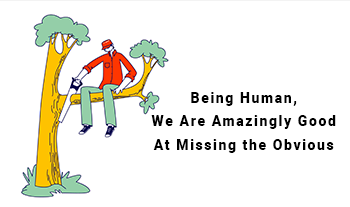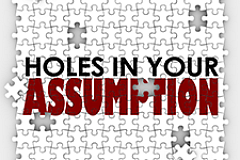 Working for large and small companies and with my own has taught me a lot about what to do and not do, but one thing has always puzzled me:
Working for large and small companies and with my own has taught me a lot about what to do and not do, but one thing has always puzzled me:
Why are good business owners who run profitable companies blind to problems and fail to fix them?
Over the years, you’ve probably seen bazaar behavior by your bosses and colleagues, some so absurd you’ve concluded that the “emperor has no clothes.”
Worse, entire companies have missed the signals that were existential threats because the “big cheese” insisted that there was no problem or just didn’t want to hear about it. Even criminal behavior goes unnoticed or is protected until the handcuffs go on!
Today, we see huge companies and the government flummoxed by the supply chain bottlenecks and lack of employees to fill jobs. Did these problems just hit us like an asteroid out of the blue? Or are they examples of “outcome blindness”?
Here’s the problem: Our brains are running on a very ancient brain software release that hasn’t received much of an upgrade since we hopped down out of the trees and became lion bait on the African savannah. We’re maybe on release 1.3 even after 100,000 years.
Limited Processor Capacity
Although our brain, our CPU, can outperform any computer in dealing with real life, it comes with just two processing cores and severely limited computational cycles.
To cope with lions and other dangerous critters, our brains evolved to selectively filter out unimportant things using “rules of thumb,” such as: If it doesn’t move don’t pay attention! There’s a snake pattern on the ground, jump the hell back!
That worked well enough when we all grunted at each other, but in today’s complex and confusing world, its simplicity can let us down.
We don’t perceive reality, we see a highly filtered version of it.
We are running on software that was optimized to keep us from getting eaten or help us find something to eat (or take for a romp in the hay) and not die from the experience. Today, it struggles to cope with the complexity of business, and sometimes life, for that matter. One significant problem is that it ignores the familiar because those things are “visibly invisible.”
That’s why we’re prone to miss problems in our companies and lives that need to correct before they become raging monsters, like too few employees, hyper-risky financial schemes, or sexual harassment scenarios.
We Resist Change
Yogi Berra said, “You can observe a lot by watching.” But lone observers are not so reliable, and, like the ostrich, we seem to have a fondness for sticking our heads in the sand.
It takes an outsider to see the obvious because the obvious is too familiar to insiders. Moreover, we naturally resist change. The old CPU rule, “Eat that new shiny red berry and you might die” is in action.
We are uncomfortable with the self-image challenge that facing up to the problem may cause us, since as “el jefe” we are supposed to be omniscient and infallible. Yeah, that’s your ego talking, and boy, is it sensitive!
[quotes]So, why do so many fail to or resist having an outside observer to assess their company from top to bottom?[/quotes] If you were a serious golfer, you’d get an outsider to observe your swing and help you keep balls in the center of the fairway and out of the water hazard! This is not so common in business, however. Ego, like an egg, is fragile.
It’s tough to face up to chronic problems and do things differently, but change is necessary and it will happen with or without you. Change happened for about the first 4.5 billion years and it’s not stopping now…especially in the business world.
We communicate in ways that have a lot of ‘white noise static’
Ever wonder why Sales and IT have a hard time understanding each other? Sometimes, it seems like broadcasting on FM to someone listening on AM. You maybe hear static and a word or two…or just static.
Why is this? Because we think everyone communicates like us and they don’t!
People have different personalities and talk and listen in markedly different ways for different types of information.
Unfortunately, our version 1.3 brain software doesn’t come with much detailed know-how about this. Our level of sophistication is pretty much limited to looking for often misleading visual cues to see if the other person is getting what we’re saying. It’s a very imperfect measure of being understood.
In other words, we communicate how we like to be communicated with and focus on talking about what we would be interested in hearing.
Fortunately, there is a way to get rid of the “white noise static” in our conversations and dramatically improve communications and understanding.
[sidebar]
What Is DISC?
Download your copy of “What is DISC?” for a deeper dive into the system. (*- Assessments 27x7)

If you would like to put this to work in your business or know more, get in touch, we are experts in applying DISC and other assessments to improve company effectiveness. Let's set up a time to talk. Brian Tracy. USA: 877.433.6225. Email Me
[/sidebar]
Four Communication Styles
At a very high level, a system has been developed to simplify our means of interpersonal communications into four categories based on what each group looks for in communication.
These are called “communication styles” and the preferred business way of referring to these styles is DISC, which can be determined by taking a simple assessment.
The DISC profile is comprised of simple, practical, and easy-to-remember individual patterns of observable behavior and emotions. It measures the intensity of characteristics using scales of directness, openness, pace, and priority to create a unique blend of four behavioral styles:
- Dominance (D): Assertive, results-focused, fast decisions, desires to lead, seeks challenges.
- Influence (I): Outgoing, persuasive, people-oriented, optimistic, loves variety.
- Steadiness (S): Very patient, favors structure and stability, operates at a steady, even pace.
- Conscientiousness (C): Data, facts, analysis-based, precise and accurate, favors structure, standards, and rules.*
Individuals within each of these styles communicate quite differently and to “get your point across” without the “white noise static,” you’ll need to tailor how you speak, what you talk about, and the pace to the way the other person prefers to be communicated with.
Understanding what they are and how to identify a person’s style empowers you to broadcast on their “frequency” so they hear your message clearly and – provided they also understand behavioral styles – can communicate with you the same way.
With that being said, we are all a blend of all four styles with one usually dominant. However, we can vary our style or “adapt” situationally so this gets a bit more nuanced.
No wonder some business researchers believe most companies only operate at 30 to 40 percent effectiveness.
The big question
If this has been interesting and has enhanced your understanding of how our minds often fool us into complacency and blind us to what is possible, what are you going to do differently to improve your business?














